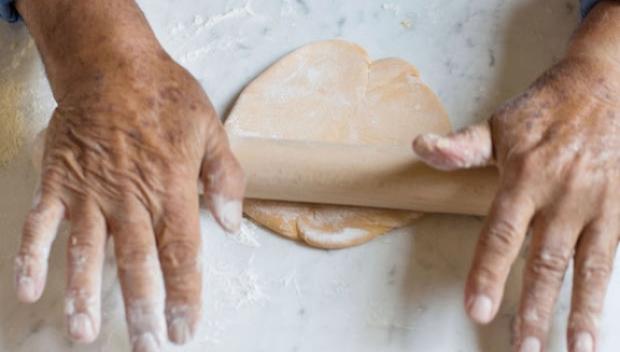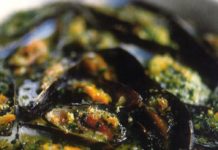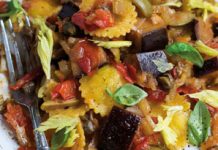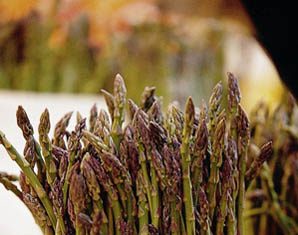
Basic Pasta Dough
The ideal proportions for the best home-made pasta dough are one large egg for every 115g (4oz) flour, but variations in temperature and humidity as well as in the in the ingredients themselves may produce slightly different textures. You may need to vary the quantity of flour slightly: the thing to aim for is a dough which has been kneaded until it is perfectly smooth and elastic, yet firm.
Pasta all’Uovo
Ingredients
- Makes 450g (1 lb) pasta dough
- 300g (10 1/2 oz) plain flour
- 3 large, very fresh eggs
- A generous pinch of salt
Instructions
- Pile the flour in a mound on a work surface. Break the eggs into the centre and add the salt. Stir the eggs into the flour, with a fork at first and then with your hands, until it forms a coarse paste. Add a little more flour if too moist.
- Now the pasta dough has to be kneaded. It should be smooth and workable, not too soft but not too hard. Do this in the machine or by hand.
- If the latter, clean your hands and the work surface first. Lightly flour the surface and your hands, and knead the dough with the heel or palm of one hand, pushing it away from you and folding it back towards you. Collect all the bits from the work surface and incorporate them into the dough. Flour the surface and your hands from time to time. After about 10 – 15 minutes the dough should be ready. Allow it to rest for 15 – 30 minutes before rolling, but cover with a cloth.
- Once again, dust the clean work surface and the rolling pin with flour. Take a part of the dough (leaving the rest still covered), and begin to roll it out gently. Always roll away from you, each time rotating the dough by a quarter turn.
- The thickness required is dependent on the type of pasta: 1.5 – 2mm (1/16 inch) for stuffed pasta, and 3 – 4mm (1/8 inch) for lasagne and cannelloni. If you are making stuffed pasta such as ravioli, then use the pasta straightaway. If you are making lasagne, cut the sheets and place them on a floured cloth to dry a little. If you are cutting ribbons, fold the sheet of pasta into a loose roll and cut it into ribbons of the desired width. Open out the rolls gently and allow them to dry for a further 10 minutes or so before cooking.
- If using a machine to roll the dough, you have to force a section of the pasta dough through at a time until the dough becomes smooth. Then you decrease the gap each time through the rollers, so that the dough becomes thinner and longer. Repeat this until you obtain the desired thickness. Then either put it through the cutting rollers to make various sizes of ribbon, or cut into sheets.
- Cook fresh pasta in a large saucepan, preferably with a rounded base. Use one litre (1 3/4 pints) water per 115g (4 oz) pasta, plus two teaspoons of salt. When you put the pasta into the pot, give it a quick stir to prevent it from sticking together (it is only with lasagne, which must be immersed one sheet at a time, that it is necessary to add a few drops of oil to the water). Cooking time varies according to the kind of pasta, its thickness and whether it is stuffed, but home-made noodles and ribbons will take between three and five minutes. Stir the pasta while it is cooking, preferably with a long wooden fork. Always test the pasta when you think it should be almost done: it is ready when it is al dente, and slightly resistant. A little before it reaches that stage, take the saucepan off the heat, add a glass of cold water, and leave for a couple of seconds. Then drain the pasta and return immediately to the saucepan or a preheated dish, mixing it with a little sauce and perhaps some grated cheese. Serve it immediately.
7.8.1.2
9
https://www.antonio-carluccio.com/pasta_alluovo/Video: Make fresh pasta in five easy steps the Carluccio’s way












